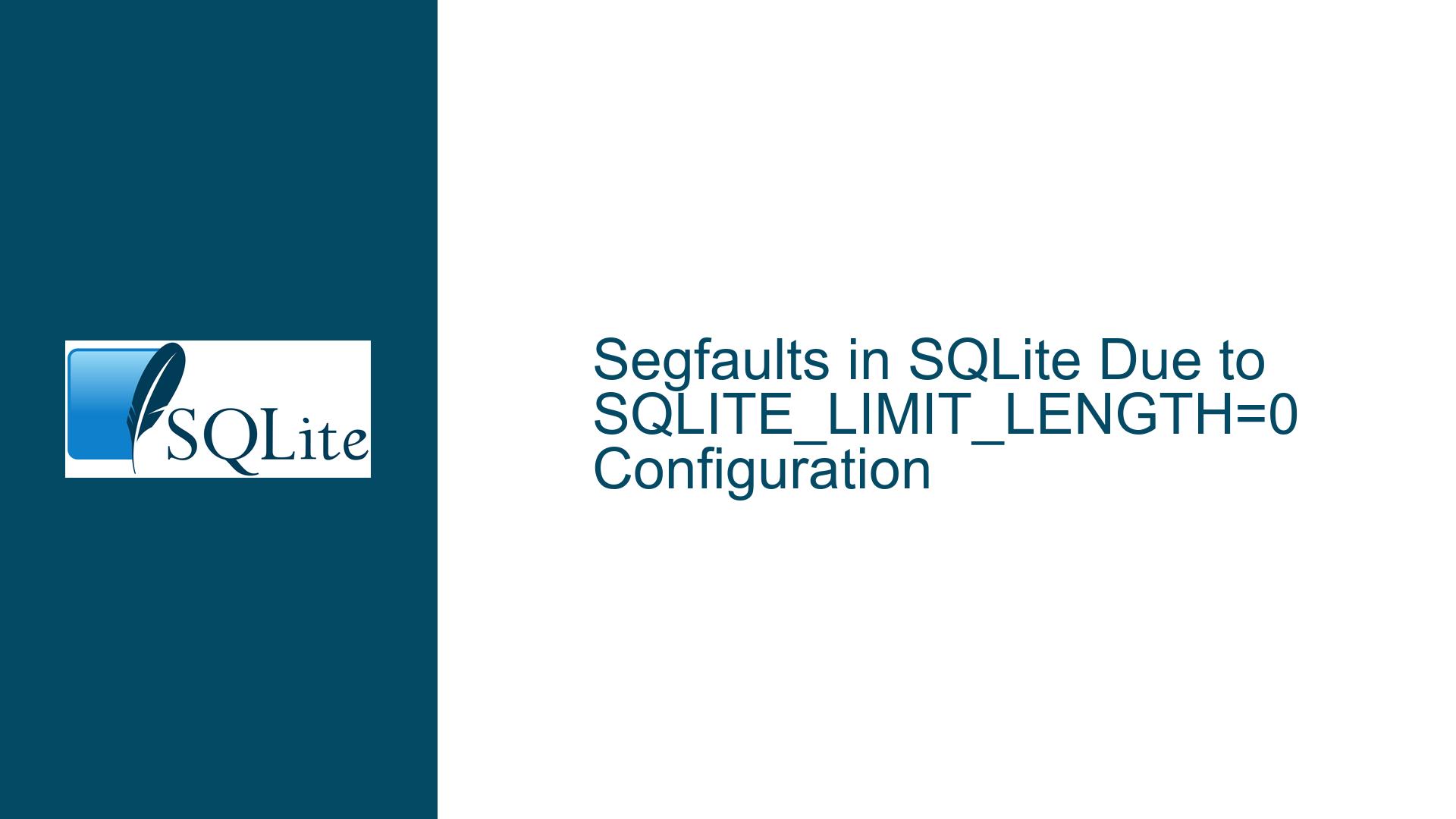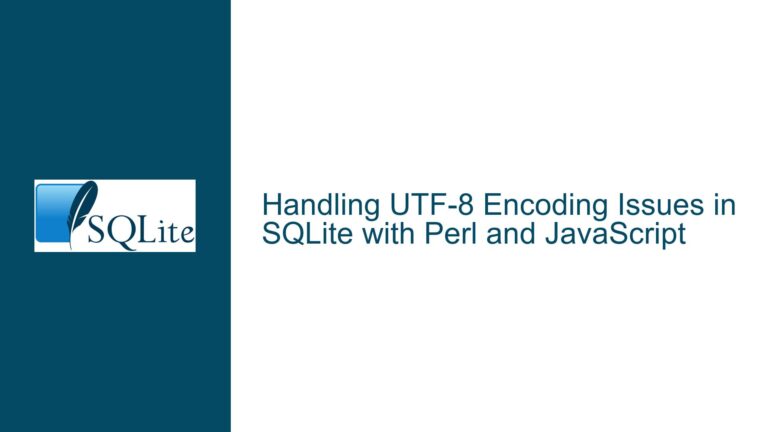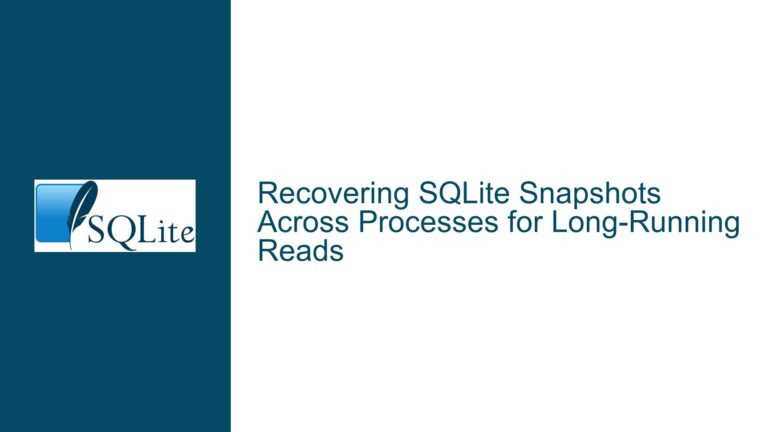Segfaults in SQLite Due to SQLITE_LIMIT_LENGTH=0 Configuration
Understanding the Segfaults in SQLite When SQLITE_LIMIT_LENGTH is Set to 0
The issue at hand revolves around a segmentation fault (segfault) occurring in SQLite when the SQLITE_LIMIT_LENGTH parameter is set to 0. This configuration, while nonsensical in practical terms, leads to a crash during the execution of the sqlite3_prepare_v2 function. The crash manifests as an error message from AddressSanitizer, indicating an attempt to free memory that was not allocated by malloc(). In some contexts, the crash may also present as a global stack underflow. This behavior highlights a critical vulnerability in SQLite’s handling of the SQLITE_LIMIT_LENGTH parameter, particularly when it is set to an invalid value.
The provided code snippet demonstrates the issue succinctly. It initializes an in-memory SQLite database, sets the SQLITE_LIMIT_LENGTH limit to 0, and attempts to prepare a SQL statement. The sqlite3_prepare_v2 function, which is responsible for compiling the SQL statement into a bytecode program, fails catastrophically under these conditions. The subsequent call to sqlite3_finalize and sqlite3_close are never reached due to the crash.
This issue is particularly concerning because it exposes a lack of safeguards in SQLite’s API when dealing with invalid or nonsensical configurations. While setting SQLITE_LIMIT_LENGTH to 0 is not a realistic use case, the absence of proper validation can lead to undefined behavior, including memory corruption and crashes. This is especially problematic in environments where SQLite is embedded within larger applications, as such crashes can have cascading effects on the overall system stability.
Exploring the Root Causes of the Segfaults in SQLite with SQLITE_LIMIT_LENGTH=0
The root cause of the segfault lies in SQLite’s handling of the SQLITE_LIMIT_LENGTH parameter when it is set to 0. The SQLITE_LIMIT_LENGTH parameter is designed to limit the maximum size of a string or BLOB in SQLite. When this limit is set to 0, it effectively disables the ability to store any data in the database, which is an invalid configuration. However, SQLite does not perform adequate validation on this parameter, leading to undefined behavior when it is set to 0.
The sqlite3_prepare_v2 function, which is responsible for compiling SQL statements into bytecode, relies on the SQLITE_LIMIT_LENGTH parameter to allocate memory for the compiled statement. When the limit is set to 0, the function attempts to allocate a buffer of size 0, which is not a valid operation. This results in an attempt to free memory that was never allocated, triggering the AddressSanitizer error. In some cases, this can also lead to a global stack underflow, further exacerbating the issue.
Another contributing factor is the lack of safeguards in SQLite’s API when dealing with invalid configurations. The SQLITE_ENABLE_API_ARMOR flag, which is designed to provide additional checks and protections in the API, is not enabled by default. This means that invalid configurations, such as setting SQLITE_LIMIT_LENGTH to 0, can slip through without being caught, leading to crashes and other undefined behavior.
The issue is further compounded by the fact that SQLite is often used in embedded systems and other environments where stability is critical. In these contexts, a crash due to an invalid configuration can have serious consequences, including data loss and system downtime. This underscores the importance of proper validation and error handling in SQLite’s API, particularly when dealing with configuration parameters that can have a significant impact on the database’s behavior.
Resolving the Segfaults in SQLite When SQLITE_LIMIT_LENGTH is Set to 0
To address the issue of segfaults in SQLite when SQLITE_LIMIT_LENGTH is set to 0, several steps can be taken. The first and most straightforward solution is to ensure that the SQLITE_LIMIT_LENGTH parameter is never set to 0. This can be achieved by adding a check in the application code to validate the value of the parameter before passing it to SQLite. If the value is 0, the application should either set it to a valid value or handle the error appropriately.
Another solution is to enable the SQLITE_ENABLE_API_ARMOR flag when compiling SQLite. This flag provides additional checks and protections in the API, including validation of configuration parameters. When this flag is enabled, SQLite will perform additional checks on the SQLITE_LIMIT_LENGTH parameter and other configuration options, preventing invalid values from causing crashes or other undefined behavior. This can be done by adding the -DSQLITE_ENABLE_API_ARMOR flag to the compiler options when building SQLite.
In addition to these solutions, it is also important to consider the broader implications of this issue. The fact that SQLite does not perform adequate validation on the SQLITE_LIMIT_LENGTH parameter highlights a potential weakness in the API. To address this, the SQLite development team should consider adding additional validation checks for this and other configuration parameters. This would help prevent similar issues from arising in the future and improve the overall stability and reliability of SQLite.
For developers who are already using SQLite in their applications, it is important to be aware of this issue and take steps to mitigate the risk of crashes. This includes validating configuration parameters, enabling the SQLITE_ENABLE_API_ARMOR flag, and keeping up to date with the latest releases of SQLite. By taking these steps, developers can ensure that their applications remain stable and reliable, even in the face of invalid configurations.
In conclusion, the issue of segfaults in SQLite when SQLITE_LIMIT_LENGTH is set to 0 is a serious one that can lead to crashes and other undefined behavior. However, by understanding the root causes of the issue and taking appropriate steps to mitigate the risk, developers can ensure that their applications remain stable and reliable. This includes validating configuration parameters, enabling the SQLITE_ENABLE_API_ARMOR flag, and staying up to date with the latest releases of SQLite. By doing so, developers can avoid the pitfalls associated with invalid configurations and ensure that their applications continue to perform as expected.






